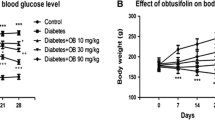Abstract
Background
Arbutin is a well-known tyrosinase inhibitor that prevents the formation of melanin through the inhibition of tyrosinase. Therefore, it has been widely used as a cosmetic skin-lightening agent. Arbutin is able to scavenge free radicals within cells and previous studies have found that it also exhibited useful activities for the treatment of diuresis, bacterial infections, and cancer, as well as anti-inflammatory and anti-tussive activities. This study analyzed the effects of arbutin on streptozotocin (STZ)-induced diabetes mellitus in a murine model.
Methods
Healthy male adult C57BL/6 mice (7 weeks old) were randomly allocated into one of the following three groups of six animals: Normal control with no STZ administration, STZ-induced diabetes, and STZ-induced diabetes treated with 0.3 g/kg/day of arbutin. After 12 days, the levels of insulin, C-peptide, and HbA1c were measured in serum, and the expression and enzymatic activities of superoxide dismutase (SOD), catalase (CAT), and glutathione peroxidase (GPx) were analyzed in pancreatic tissues by western blotting.
Results
Arbutin was found to significantly inhibit the increase in blood glucose and the loss of body weight in diabetic mice. Arbutin increased plasma insulin levels in mice with STZ-induced diabetes, whereas there was no detection of insulin in untreated diabetic mice. In addition, there was an increased expression and activity of SOD, CAT, and GPx in diabetic mice treated with arbutin.
Conclusions
This investigation demonstrated that arbutin possesses antioxidant activities and can alleviate symptoms of type-1 diabetes mellitus (T1DM) in mice.




Similar content being viewed by others
Abbreviations
- STZ:
-
streptozotocin
- CAT:
-
catalase
- DM:
-
diabetes mellitus
- T1DM:
-
type-1 diabetes mellitus
- SOD:
-
superoxide dismutase
- GPx:
-
glutathione peroxidase
- ROS:
-
reactive oxygen species
References
Biosa A, Outeiro TF, Bubacco L, Bisaglia M. Diabetes mellitus as a risk factor for Parkinson’s disease: a molecular point of view. Mol Neurobiol. 2018;55(11):8754–63.
Fakhruddin S, Alanazi W, Jackson KE. Diabetes-induced reactive oxygen species: mechanism of their generation and role in renal injury. J Diabetes Res. 2017;2017:1–30.
Rivera-Yañez N, Rodriguez-Canales M, Nieto-Yañez O, Jimenez-Estrada M, Ibarra-Barajas M, Canales-Martinez M, et al. Hypoglycaemic and antioxidant effects of propolis of Chihuahua in a model of experimental diabetes. Evid Based Complement Alternat Med. 2018;2018:1–10.
Scalbert A, Manach C, Morand C, Rémésy C, Jiménez L. Dietary polyphenols and the prevention of diseases. Crit Rev Food Sci Nutr. 2005;45(4):287–306.
Balandrin MF, Klocke JA, Wurtele ES, Bollinger WH. Natural plant chemicals: sources of industrial and medicinal materials. Science. 1985;228(4704):1154–60.
Zhou L, Fu X, Jiang L, Wang L, Bai S, Jiao Y, et al. Arbutin increases Caenorhabditis elegans longevity and stress resistance. PeerJ. 2017;5:e4170.
Chakraborty AK, Funasaka Y, Komoto M, Ichihashi M. Effect of arbutin on melanogenic proteins in human melanocytes. Pigment Cell Res. 1998;11(4):206–12.
Lim Y-J, Lee EH, Kang TH, Ha SK, Oh MS, Kim SM, et al. Inhibitory effects of arbutin on melanin biosynthesis of α-melanocyte stimulating hormone-induced hyperpigmentation in cultured brownish Guinea pig skin tissues. Arch Pharm Res. 2009;32(3):367–73.
Hermanns J, Petit L, Martalo O, Pierard-Franchimont C, Cauwenbergh G, Pierard G. Unraveling the patterns of subclinical pheomelanin-enriched facial hyperpigmentation: effect of depigmenting agents. Dermatology. 2000;201(2):118–22.
Khanal T, Kim HG, Hwang YP, Kong MJ, Kang MJ, Yeo HK, et al. Role of metabolism by the human intestinal microflora in arbutin-induced cytotoxicity in HepG2 cell cultures. Biochem Biophys Res Commun. 2011;413(2):318–24.
Hu Z-M, Zhou Q, Lei T-C, Ding S-F, Xu S-Z. Effects of hydroquinone and its glucoside derivatives on melanogenesis and antioxidation: biosafety as skin whitening agents. J Dermatol Sci. 2009;55(3):179–84.
Li H, Jeong Y-M, Kim SY, Kim M-K, Kim D-S. Arbutin inhibits TCCSUP human bladder cancer cell proliferation via up-regulation of p21. Pharmazie. 2011;66(4):306–9.
Mustapha N, Mokdad-Bzéouich I, Maatouk M, Ghedira K, Hennebelle T, Chekir-Ghedira L. Antitumoral, antioxidant, and antimelanogenesis potencies of hawthorn, a potential natural agent in the treatment of melanoma. Melanoma Res. 2016;26(3):211–22.
McLellan AC, Thornalley PJ, Benn J, Sonksen PH. Glyoxalase system in clinical diabetes mellitus and correlation with diabetic complications. Clin Sci. 1994;87(1):21–9.
Rolo AP, Palmeira CM. Diabetes and mitochondrial function: role of hyperglycemia and oxidative stress. Toxicol Appl Pharmacol. 2006;212(2):167–78.
Zhou B, Zou H, Xu G. Clinical utility of serum cystatin c in predicting diabetic nephropathy among patients with diabetes mellitus: a meta-analysis. Kidney Blood Press Res. 2016;41(6):919–28.
Yang DK, Kang H-S. Anti-diabetic effect of Cotreatment with Quercetin and resveratrol in Streptozotocin-induced diabetic rats. Biomol Ther. 2018;26(2):130–8.
Go H-K, Rahman MM, Kim G-B, Na C-S, Song C-H, Kim J-S, et al. Antidiabetic effects of yam (Dioscorea batatas) and its active constituent, allantoin, in a rat model of streptozotocin-induced diabetes. Nutrients. 2015;7(10):8532–44.
Cersosimo E, Solis-Herrera C, Trautmann ME, Malloy J, Triplitt CL. Assessment of pancreatic β-cell function: review of methods and clinical applications. Curr Diabetes Rev. 2014;10(1):2–42.
Saisho Y, Kou K, Tanaka K, Abe T, Kurosawa H, Shimada A, et al. Postprandial serum C-peptide to plasma glucose ratio as a predictor of subsequent insulin treatment in patients with type 2 diabetes. Endocr J. 2011;58(4):315–22.
Funding
This work was funded by the Jiangsu Province Natural Science Foundation (BK20151046) and the National Natural Science Foundation of China (81603586).
Author information
Authors and Affiliations
Corresponding authors
Ethics declarations
Conflict of interest
The authors declare that they have no conflicts of interest.
Ethnical approval
All animals were maintained and used in accordance with the guidelines of the Institutional Animal Care and Use Committee of the Nanjing University of Chinese Medicine, China. All of the experimental procedures were approved by the ethics committee of the Nanjing University of Chinese Medicine.
Additional information
Publisher’s note
Springer Nature remains neutral with regard to jurisdictional claims in published maps and institutional affiliations.
Rights and permissions
About this article
Cite this article
Li, H., Cao, W., Wei, LF. et al. Arbutin alleviates diabetic symptoms by attenuating oxidative stress in a mouse model of type 1 diabetes. Int J Diabetes Dev Ctries 41, 586–592 (2021). https://doi.org/10.1007/s13410-021-00920-0
Received:
Accepted:
Published:
Issue Date:
DOI: https://doi.org/10.1007/s13410-021-00920-0




